The multiple oil crises of the 1970s reshaped American car culture. Land yachts were out, and compacts were in. Horsepower was down, but so were emissions. The RV world also took a hit, as fewer people could afford to go camping, while others now had smaller, less-capable tow vehicles. One company pitched a new camper as the solution. The 1975 Farenwald Metric was a tiny, only 12-foot-long, affordable camper designed to be hauled by the smallest cars of the 1970s. Now, it’s a rare and forgotten piece of RV history.
The events of the infamous 1970s frequently show up in automotive history columns. By now, you’ve certainly heard it all, from the oil crisis of 1973 scaring America into building smaller, more efficient vehicles, to how America got stuck in a trough. The economy plummeted, Americans stopped spending, and consumer confidence hit historic lows. The 1970s were also an era when America made monumental upgrades in vehicle safety and emissions reductions.
Less often talked about is what happened to the RV industry. If you thought that the cars of the early 1970s were gas guzzlers, those cars and trucks gulped down heaps of fuel when towing camper trailers. Meanwhile, motorhomes had been getting larger and more luxurious in the prior years, and practically overnight, having lumbering giants became a potential liability. The RV industry had spent the 1960s enjoying the good fortunes of Americans who had rediscovered the outdoors. Now, people wondered where their next tank of gas was going to come from, forget about buying that dream RV.

Countless RV manufacturers folded in the 1970s as demand cratered. What was wild was how slow the RV industry was to react to changing times. In January 1977, Woodall’s Trailer and RV Travel reported that despite the struggles brought on by the oil crisis, the market for smaller, more economical trailers had remained pretty flat. Brands like Scamp did build tiny campers, but they were small fish in a vast ocean. Most builders who were able to weather the storm continued cranking out large units. However, the magazine noted, part of the reason might have been because RV sales had a strong recovery in 1975 and 1976, so perhaps manufacturers felt that they were out of the woods.
Keep in mind that there wasn’t just one oil shock that happened in the 1970s, but multiple ones. As politics publication State Affairs writes, the RV sector in Indiana was bludgeoned by oil shocks in 1979. As Americans stopped buying campers, RV manufacturers reacted by laying off workers. Indiana’s unemployment rate doubled from 5.6 percent in 1979 to 10.8 percent in 1982.
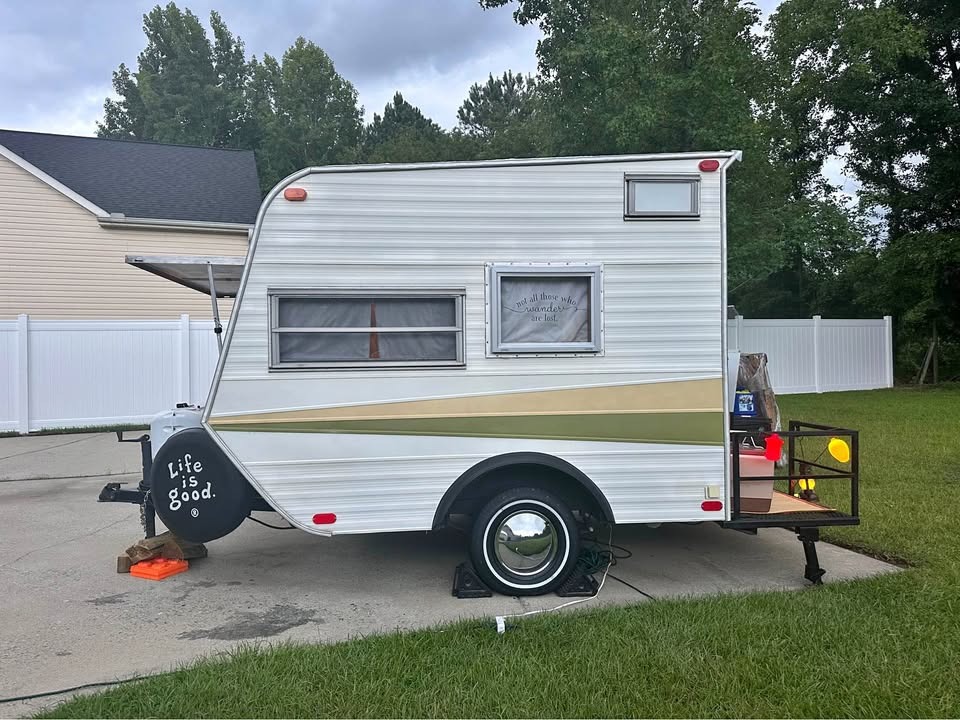
This is all to say that the Malaise Era sort of hit campers, too. But one brand saw itself as being flexible enough to compensate for the new era. Farenwald Enterprises launched the Metric line of campers, and they were supposed to be the ultimate camper for the frugal 1970s traveler.
Farenwald
While I have not been able to piece together a full history for Farenwald Enterprises, Inc., I have been able to connect most of the dots. The company was based out of Lancaster, Pennsylvania, and in 1969, it trademarked the FEI and the Dutch Craft trailer brands. According to corporate indexes on the Internet Archive, Farenwald also operated a bass boat and boat trailer enterprise out of Pennsylvania and a Florida subsidiary.
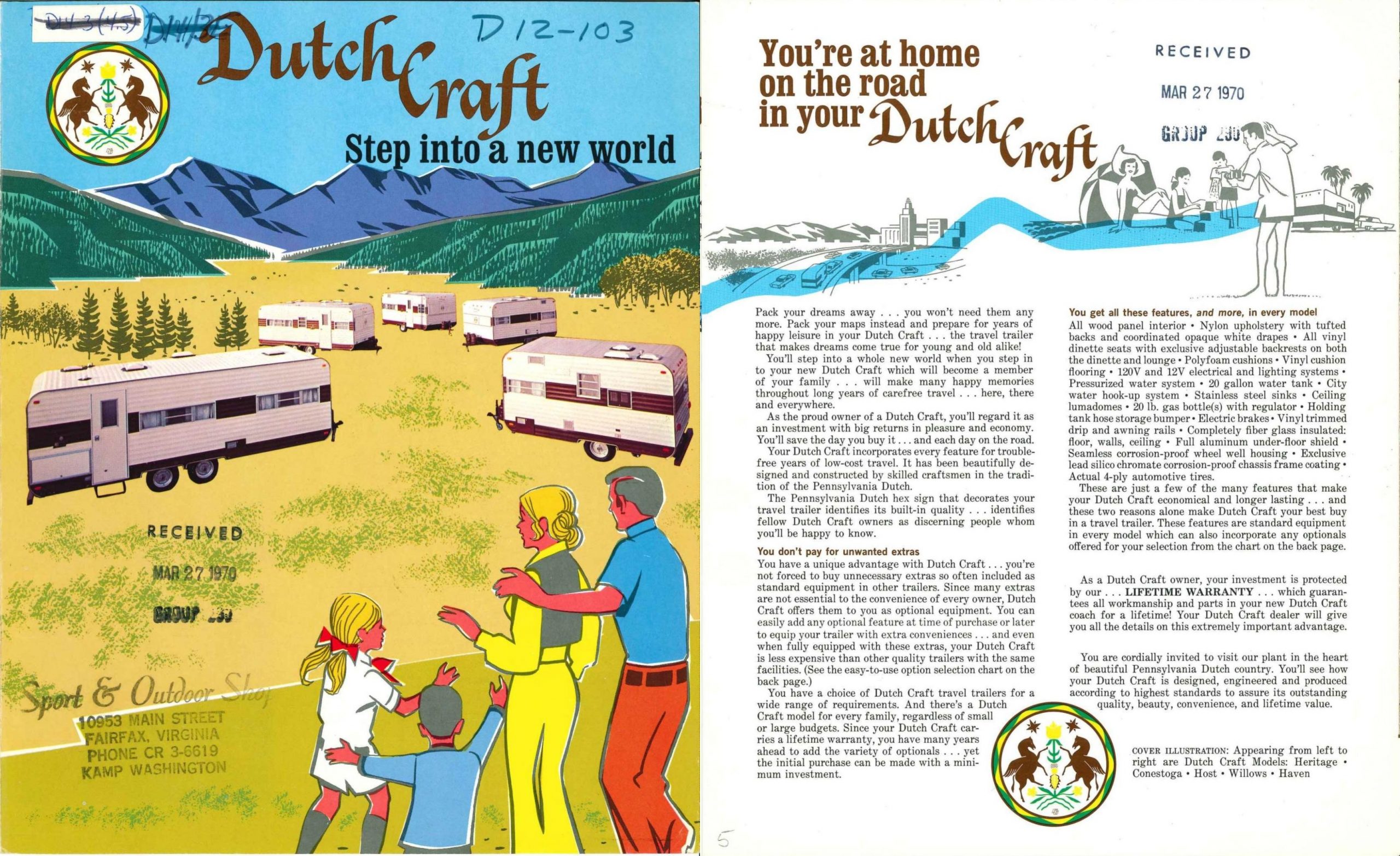
Dutch Craft trailers were marketed as long-lasting luxury trailers featuring aluminum subfloors, “corrosion-proof” frames, and quality that was backed by a lifetime warranty. Farenwald also said that its Dutch Craft trailers had “been beautifully designed and constructed by skilled craftsmen in the tradition of the Pennsylvania Dutch.” The marketing for the trailers was ambitious, saying that they were so luxurious and so well-built that a Dutch Craft trailer could make dreams come true for both young and old people for years to come.
In 1970, Farenwald’s smallest Dutch Craft trailer was the 15.5′ Haven, which weighed 1,960 pounds empty without options, or 2,280 pounds with every option. In 1975, for the 1976 model year, Farenwald came up with something even smaller. That year, it launched Metric, LTD. as its brand for compact camper trailers.
The Metric
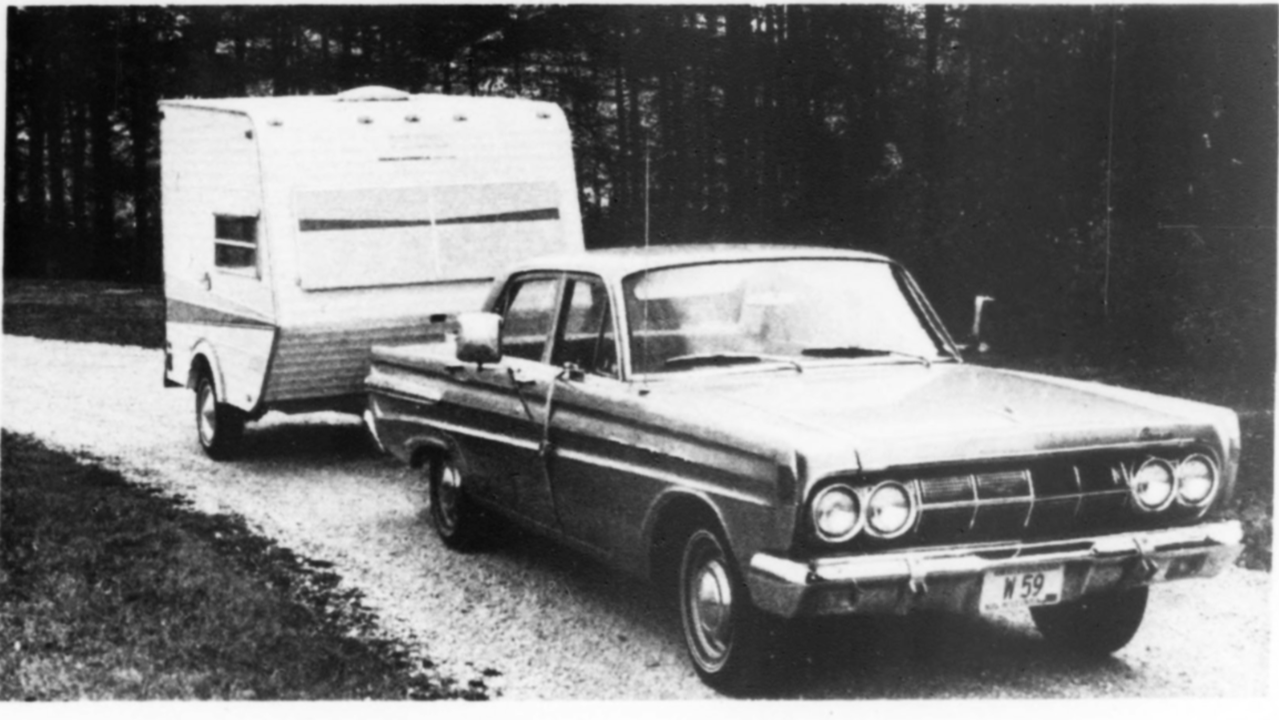
As Dick Morch from Woodall’s Trailer and RV Travel noted in 1977, Farenwald’s move to make a tiny camper was a bold one. As I noted, camper sales had recovered from the initial impact of the first oil crisis, and the later crisis hadn’t happened yet. Farenwald was going against the grain by making a 12-foot camper rather than a huge one.
Morch starts by talking about the Farenwald Metric’s interior, which the publication said has the same kind of wedge design made famous by the sports cars of the era. Morch goes on to say that while Farenwald’s designers were primarily interested in creating a distinctive trailer, they also achieved creating one that was quite aerodynamic for its day, which was good news for fuel consumption-conscious customers.
Also good was the trailer’s weight. It was just 1,260 pounds, which Morch says meant that the trailer could be towed by a low-powered car without modifications to its cooling system. This was helped by the tiny size, as in addition to the trailer’s 12’10” length, it was just 6’6.5″ wide, or 12 to 18 inches narrower than a typical larger trailer of the era.
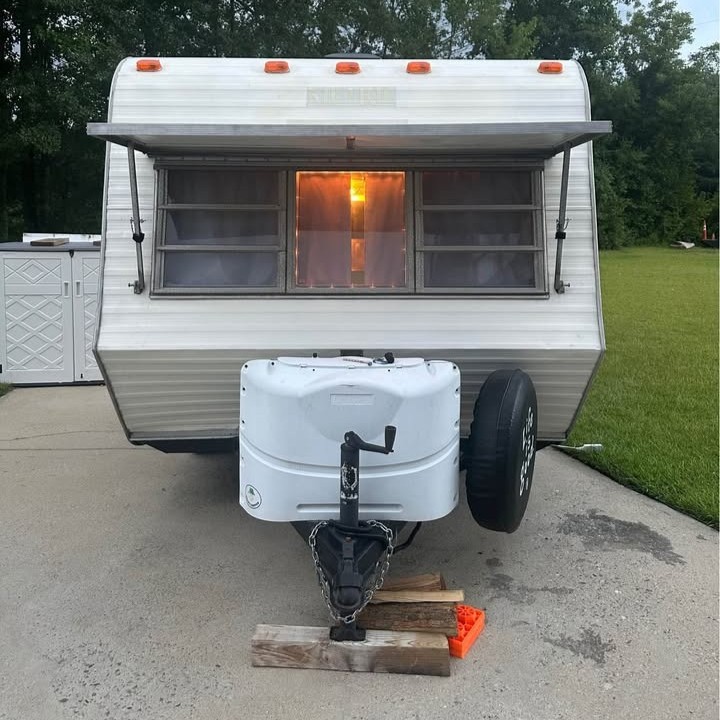
Morch continues by talking about how the trailer was constructed in the era’s typical fashion. It features wood two-by-two framing, spun fiberglass insulation, and aluminum sheets for outer skin. No so-called “corrosion-proof” frame makes an appearance here, and the subfloor isn’t aluminum. As Morch explains, several RV manufacturers had stopped using aluminum subfloors in the 1970s in favor of using undercoating on the wood floor structure. The manufacturers thought that undercoating worked just as well as aluminum. Morch admitted that he still preferred the old-school metal subfloors.
In fairness to the Metric, I wouldn’t have expected it to be a leader in construction innovation. It was more or less the 1970s equivalent of a Coleman trailer today, and that’s not an insult. It wasn’t built to last the rest of your life, but to produce at least some years of fun camping.
At any rate, Morch said that the Metric did have better workmanship than the typical trailer, which is great. Morch also specifically noted that the roof was “well sealed,” which I suppose illuminates just how bad some campers used to be when brand new. Morch also complimented the trailer’s interior workmanship and cabinetry for being good.
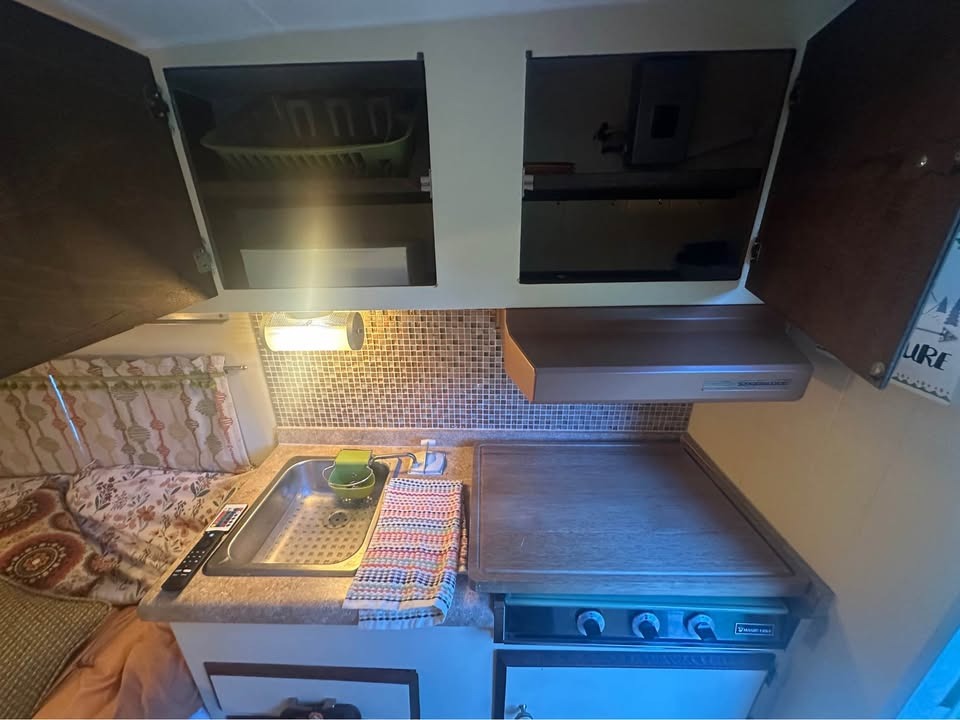
However, not everything was good on the publication’s brand-new test camper. Morch noted that the trailer’s surge brakes didn’t work. Somehow, worse was that the water system was just incomplete. The RV publication noted that the trailer was missing a hose clamp on the water tank, which meant that water leaked out all over the trailer’s floor when the reviewer attempted to fill the tank. Worse, the water tank didn’t have a drain, so the only way to remove water from it was to pump it out. Somehow, worse still, the hand pump in the trailer didn’t have a valve to stop the flow of water when the trailer was hooked up to a city water connection.
Well, at least it’s amusing to see that even RVers from the ’70s had to deal with totally asinine faults in brand-new trailers. At least Farenwald took Morch’s criticism and made design changes to the water system to prevent these issues.
Morch noted that the camper’s real party trick was in its interior design. The box of the trailer is just barely over 8 feet long, so designers got creative. The trailer’s entry door is on the rear, which was unusual for a travel trailer back then. Such a design was the standard layout for a truck bed camper. Morch called the interior space “compact,” but complimented its 50 cubic feet of storage space and sleeping arrangements, provided that the trailer’s occupants were a couple rather than a family.

If you brought kids, the trailer does have a bunk for up to two children to sleep in. However, Morch warned that one bunk has poor ventilation and is unbearable on a hot day. Compliments return with the kitchen, with Morch saying that the kitchen is one of the best in the mini camper class. Appliances came in the form of a three-burner stove, icebox, a stainless steel sink, and a hand pump water system, which isn’t much, but the trailer had a rather spacious kitchen for its size.
Options were few, and included a power range hood ($35), an oven ($90), a 10,000 BTU heater ($120), a battery ($70), a refrigerator ($300), and surge brakes ($140). The trailer itself was $1,995 before options and came with electric brakes. A bathroom wasn’t an option, and neither was an air conditioner.
What I really love about Morch’s review is that it featured a towing test with measurements, like a sort of camper Car and Driver. Morch hooked the Metric up to a stock 1964 Mercury Comet. Morch said that the trailer scored good marks for handling, but did note that good handling was pretty much the standard for mini campers. What was more interesting to me was that Morch actually measured acceleration times. The Mercury Comet towing the Farenwald Metric hit 60 mph in 19.8 seconds, which was 6 seconds slower than the car when unloaded. The car also achieved 13 mpg while towing at 55 mph, compared to 20.3 mpg when empty.
This 1976 Farenwald Metric
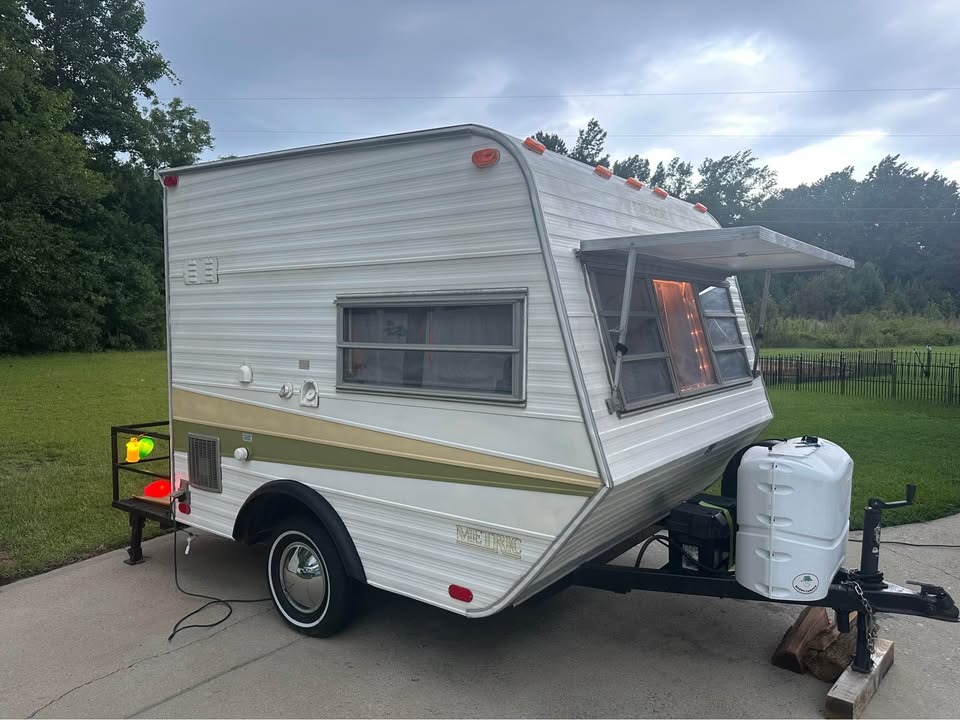
This brings us to the 1976 Farenwald Metric that’s for sale today on Facebook Marketplace in Angier, North Carolina.
Images for the listing show that the camper went through the camper equivalent of a restomod. The trailer has its original body, but now it has a rear porch and a pair of stabilizer jacks. It’s a small touch, but a neat one! The trailer’s frame also appears to be in great shape for its age, which is also good.
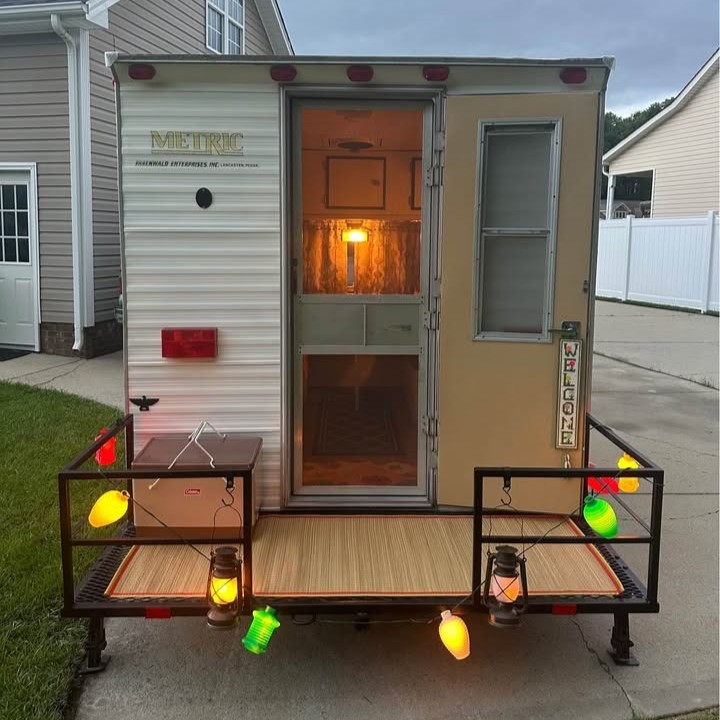
Moving inside, the trailer is a mix of original and new. The listing states:
Both the interior and exterior are in outstanding condition, meticulously cared for and preserved. All appliances including air conditioner, fridge, microwave, tv, stove and furnace working great.
Deceptively Spacious: Sleeps 2 adults comfortably on the fold-down dinette bed, plus a folding bunk bed above — ideal for a child or extra storage. Also included are matching side and rear awnings and a rv cover!
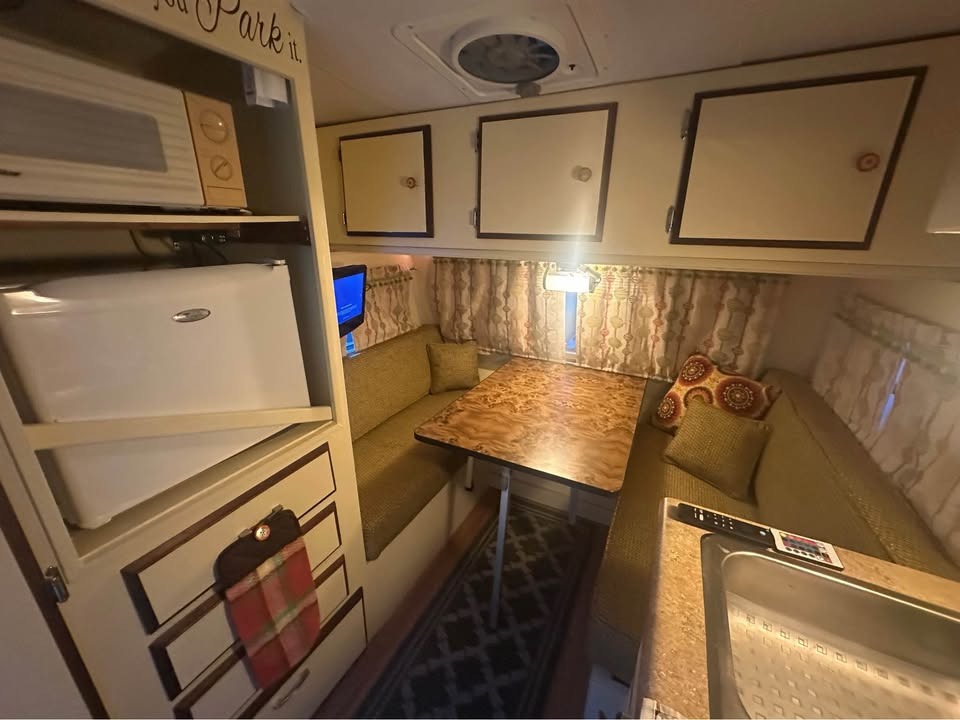
The upgrades are welcome here, I think. An icebox wouldn’t be so fun to live with today, so a small refrigerator is nice. The microwave is also pretty neat, and I like the presence of the original stove and furnace. Critically, however, the trailer now has a portable air-conditioner, which these trailers would have never had when new.
I’m in love with how original the trailer is. While full nut and bolt camper restorations are great, I do like to see people preserving a trailer as a time capsule while adding modern touches. Also attractive, I think, is the price of $7,500. The trailer appears to be in decent shape, and it is fun and weird. I could see myself paying that price!
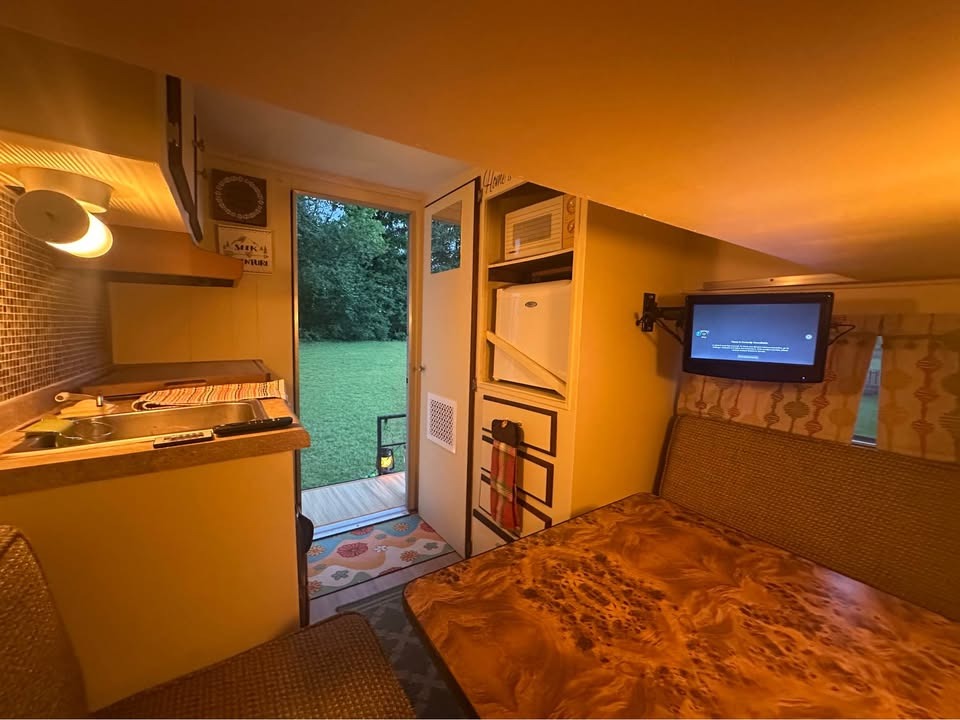
Morch concludes his review by saying that it wasn’t sure if making a tiny camper was going to be a winning strategy, but at least Farenwald created something distinctive. Sadly, Farenwald might have been too ambitious because Metric campers were sold from 1976 to 1977. Farenwald itself didn’t falter–records show Farenwald camper brands were operating well into the late 1990s, but for whatever reason, the Metric was a short-lived project.
So, this little camper is a rare little guy. Nobody knows how many of these were built, and who knows how many have survived in good shape. I know I haven’t seen one of these for sale before. Sure, it’s not perfect. There’s no bathroom, and you wouldn’t want to bring kids with you, but it’s as cute as a button. Thankfully, I am not in the market for a camper right now, or else I’d be on my way to North Carolina right now.









If you are a couple going to a campground that has bathroom facilities, then you are all set! This has all you need. I might want to figure out a way to add A/C though.
They chopped it in the wrong direction.
Length has barely any effect on fuel economy.
They should have reduced the frontal area.
We had a Hi-Lo trailer. I was a hard shell version of a pop-up trailer that shrunk to about the same height as the station wagon used to tow it. Towing that impacted fuel economy less than half as much as the ham can trailer we had before it.
This truncated trailer would look great paired with an AMC Gremlin
These tiny campers were not at all uncommon this side of the pond – after all we needed solutions for when the car towing the camper had a sub-1.2L engine making less than 50hp, so most camper brands had compact models. I’d love to tow one with the Renault 4 just for the madness of it. But for that I’d have to install a tow hook and have it approved by an independent inspection which I’m not sure the R4 would pass.
A very popular lightweight “camper” option in my neck of the woods (albeit less practical than any traditional camper) is the trailer tent. Check out this Portuguese website that seems to be using catalogue pics from the early 90s or so, despite still making these on demand. These things are so freaking cool! Also, they’re normally below the legal towing weight that would require the driver to have a special towing license in their driver’s license.
I have an irrational love for these things, as I grew up camping with my friends, and a couple of them had their family’s trailer tents permanently setup in the camping grounds we used to go to. The trailer tents were the places where whole camping party hung out at night, before we had to retire to our tents to sleep on the ground. The leap in comfort seemed unreal in trailer tents, despite still being tents: proper beds with comfy matresses; large, separated areas within the tent; levelling systems, etc. Sometimes we’d have access to a normal camper as well, and we’d still hang out in the trailer tents because they had room for more people.
Morch? Sounds like Torch has a time-traveling alter ego with a penchant for small, weird campers.
I really like rear entry layouts, they seem to work so much better with small trailers. The layout isnt all that different from a modern Aliner Ascape or Weiscraft Little Joe, though I guess there are limits to how many variations you can do
I am all for small trailers, but it looks like half a rig from the outside.
It reminds me of the Aristocrat Low Liner.
Let’s be honest the regulations in the 70s to appease the tree huggers sappedcthe power so much that to haul anything you needed to buy commercial vehicles causing more pollution so the stop pollution hippies caused more pollution.
“Tree Huggers” like anyone who lived in a city and actually wanted to breathe?
He’s always got the worst takes.
That is a prefect take. As an old tree hugger and a 60’s/70’s hippie my ride was small Suzuki bikes and a rusty 40 HP Karmann Ghia.
Yes, let’s be honest, instead of revisionist. The future has to come from somewhere, and it was the initiatives led by the “tree hugging hippies” and science fiction nerds who brought us to where we are today. Remember when 1 horsepower per cubic inch was the holy grail of power production in an ICE vehicle? Now we have affordable access to engines that produce 2 to 3 hp per cubic inch and also make a tiny fraction of the pollution that cars were making prior to the gas crunch. Oh, and we also have practical electric vehicles that get the equivalent of 80 – 120 mpg on a routine basis. I’m supremely thankful for those tree huggers and other nerds who dragged our crying, screaming, backwards asses into the future.
This was not the first try at a small rear entry trailer. My neighbor has a restored Safari 13′ rear entry trailer with a full size bed, kitchen and a bathroom of sorts. The basic structure is like this ad https://offerup.com/item/detail/ad2281c9-af34-3799-8c1d-0a424913892e
but the work was done by someone else and the color and detailing differ. She towed it with a Subaru Outback
No bathroom and a barely-there water system sold me on my current camper. The campground can supply the bathroom. They even clean it (no, seriously, they do!). A camper is the worst parts of a house and a trailer put together. Knowing this going in has helped temper expectations.
Smaller campers seem to be having a moment again. Seeing how many people got outside during COVID and needed something towable with a smaller vehicle was neat. Supply chain shocks disrupted smaller campers less than larger ones due to less going into them.
“The 1975 Farenwald Metric was a tiny, only 12-foot-long…”
Incongruous. If you’re gonna call it the “Metric”, you should tell me it’s 3.65 meters long!
Horsepower was down because of the realization that excessive emissions were killing us, and we were addicted to a globally traded, volatile substance we had no control over. Now that we’ve actually thrown some science at the problem, and not taken a ‘we’ve always done it that way’ approach, we’ve got stellar horsepower numbers, great fuel economy and really clean cars. It was worth it in the end to stop and reevaluate what we were doing.
Thank God for science. I’m sure even without the gas crisis some automaker would have introduced better and better engines as time went on. It just sped things up a bit.
I doubt it. American manufacturers were more interested in selling bigger, thirstier, more powerful cars for bigger profits to customers with the money to buy those bigger, thirstier more powerful cars.
Agreed, but I didn’t limit it to American manufacturing. If they kept it up long enough someone would come with a dramatically better engine and they would have to licence it or lose big time.
There were already dramatically better engines:
https://enginestories.com/history/global-shifts-how-japan-revolutionized-the-car-industry-in-the-1970s/
https://en.m.wikipedia.org/wiki/CVCC
https://en.m.wikipedia.org/wiki/Buick_V6_engine
Just to name a few.
I had just started working at a service station before the oil embargo hit. I recall having to get to the station by 5 AM and even then the lines were forming.
We had to block the driveways because otherwise there’s be people parked all which way at the six pumps waiting for us to open.
My first task was to stick the tanks (literally sticking a long calibrated pole into the in ground tanks to determine how much fuel was in each of three tanks. The tank caps had to be padlocked for the first time ever since people had tried to siphon fuel from them late at night. I’d convert the tank measurements into approximate gallons of fuel and that into an estimate of how many cars we could service. Next we’d reset the pump prices if necessary, then create one way flow lanes for cars entering and exiting. People coming for repairs were routed. to the apartment parking lots behind the station. Then we’d switch on the pumps and lights and get busy.
Early on in the shortage, we just pumped until we were close to empty (needed a small reserve for the station vehicles and our cars), then close down, but pretty soon I had to walk down that line of cars and put a last car sign on the estimated final car we could fill. You should have heard the screams and abuse hurled my way and looks on the faces when people saw me coming and prayed I’d bypass them. Later we had to ration gas, first $10 per car then just $5. This was not popular. And of course we were accused of saving fuel for friends and pumping after hours (which, I confess, did happen now and then, but not often. Mostly just for emergencies.)
One of my best buddies back then was a super nice guy whose family owned a small RV business. There were some very slim years for the family, but they persevered through tough times through excellent service and comprehensive knowledge about their products and the industry. He went on to found Campers Inn RV with 25 dealerships up and down the East Coast, serve on the RVDA board in several leadership positions and win all of the industries’ highest awards in addition to being a huge investor and donor in multiple charitable institutions.
I haven’t seen him in nearly 50 years since I used to fill up his company trucks and our high school graduation. Your story of the tiny fuel crisis fighting trailer raised many memories of those days. Thanks.
“Hi – I’d like a foot-long with sauerkraut, onions and mustard, a bag of chips, and a Sprite.”
“Sir – This isn’t that kind of trailer”
That’s because most of the US is deathly afraid of anything resembling a Metric system.
Or the ability to learn something, anything, new.
Wow, you just broke the internet with the dumbest comment of the day.